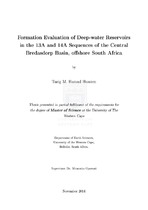| dc.description.abstract | The goal of this study is to enhance the evaluation of subsurface reservoirs by improving the prediction of petrophysical parameters through the integration of wireline logs and core measurements. Formation evaluations of 13A and 14A sequences in the Bredasdorp Basin, offshore South Africa have been performed. Five wells in the central area of the basin have been selected for this study. Four different lithofacies (A, B, C, D) were identified, in the two cored wells, and used to
predict the lithofacies from wireline logs in uncored intervals and wells. A method based on artificial neural network was used for this prediction. Facies A and B were recognized as reservoir rocks and 13 reservoir zones were identified and successfully evaluated in a detailed petrophysical model. The final shale volume was considered to be the minimum among five different methods applied in this study at any point along the well log. The porosity model was taken from the density model. A value of 2.66 g/cm3 was obtained from core measurements as
the field average grain density, whereas the value of the fluid density of 0.79 g/cm3 was obtained from core porosity and bulk density cross-plot. In a water saturation model; an average water resistivity of 0.135 Ohm-m was estimated
from SP method. The calculated water saturation models were calibrated with core
measurements, and the Indonesia model best matched with the water saturation from conventional core analysis. Six hydraulic flow units were recognized in the studied reservoirs, and were used for permeability predictions. The permeability predicted from hydraulic flow units were found more reliable than the permeability calculated from porosity-permeability relationship. The net pay was identified for each reservoir by applying cut-offs on permeability 0.1 mD, porosity 7%, shale volume 0.35, and water saturation 0.60. The gross thickness of the reservoirs ranges from 4.83m to 41.07m and net pay intervals from 1.21m to 29.59m. | en_US |

